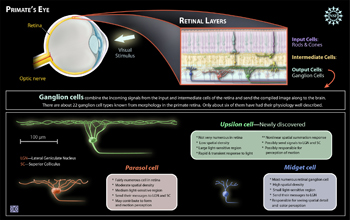Multimedia Gallery
A graphic showing the eye, the retina with three layers and three types of retinal ganglion cells.
The eye's retina is composed of three layers of cells. Rods and cones are in the input cell layer. They sense light and convert this information into electrical signals that they send along to the intermediate cell layer. Those cells then transfer the signals to the output cells or "retinal ganglion cells." There are about 22 ganglion cell types known in the primate retina but only about six of them have been well-described physiologically. Recently researchers have been able to describe the electrophysiology of the upsilon cell. The renderings shown here are an artist's conception. No micrographs of these cells have been taken yet.
Credit: National Science Foundation
Images credited to the National Science Foundation, a federal agency, are in the public domain. The images were created by employees of the United States Government as part of their official duties or prepared by contractors as "works for hire" for NSF. You may freely use NSF-credited images and, at your discretion, credit NSF with a "Courtesy: National Science Foundation" notation.
Additional information about general usage can be found in Conditions.
Also Available:
Download the high-resolution JPG version of the image. (957 KB)
Use your mouse to right-click (Mac users may need to Ctrl-click) the link above and choose the option that will save the file or target to your computer.
Related story: New Type of Retinal Cell Discovered in Primates

